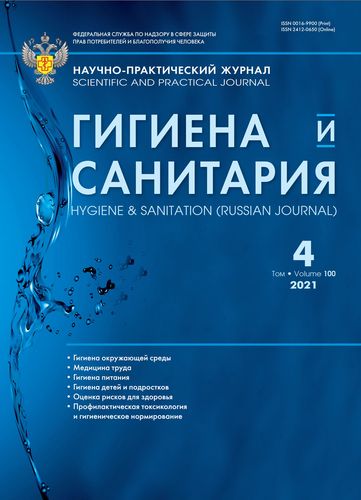Methodology for environmental health assessment of adaptive response to professional activity factors as part of health risk assessment
- Authors: Meshkov N.A.1, Rakhmanin Y.A.2
-
Affiliations:
- Izmerov Research Institute of Occupational Health
- Centre for Strategic Planning and Management of Biomedical Health Risks
- Issue: Vol 100, No 4 (2021)
- Pages: 387-395
- Section: HEALTH RISK ASSESSMENT
- Published: 13.05.2021
- URL: https://edgccjournal.org/0016-9900/article/view/639446
- DOI: https://doi.org/10.47470/0016-9900-2021-100-4-387-395
- ID: 639446
Cite item
Full Text
Abstract
Introduction. The article presents the findings of a study of the adaptive responses of working people depending on their professional activity nature.
The purpose of the study is to evaluate the adaptive response of working people exposed to harmful and dangerous factors.
Material and methods. The research involved 225 people, including 157 cases exposed to different hazards and dangers: Chernobyl nuclear power plant disaster relief workers (their average age was 59.2 ± 2.2 years (M ± m)); servicemen working with rocket fuels (their average age was 30.6 ± 1.3 years (M ± m)); and service members participated in combat operations (their average age was 32.0 ± 0.8 years (M ± m)). A set of standard methods was used to assess their cardiorespiratory system’s functional state, biological age, activity levels in different organs, and adaptive abilities.
Results. The study has made it possible to describe distribution in terms of ANS response, biological age, adaptive potential, and their correlation. The relief workers showed a medium inverse correlation between adaptive potential and ANS response type (r = -0.308; р = 0.153) and a significant medium positive correlation between adaptive potential and biological age (r = 0.690; р < 0.001). The servicemen working with rocket fuels showed a high medium positive correlation (r = 0.726; р = 0.001) and a significant medium positive correlation (r = 0.658; р < 0.004) between adaptive potential and ANS response type and biological age, respectively. The servicemen who had participated in combat operations showed weak inverse correlation (r = -0.139; р = 0.155) and medium positive correlation (r = 0.683; р = 0.005) in the first and second case, respectively.
Conclusion. The biological age, individual aging rate, ANS response, and potential adaptive performance can be used as criteria for assessing health risks for working people exposed to different hazards and dangers and determining groups of people who need case follow-up.
About the authors
Nikolay A. Meshkov
Izmerov Research Institute of Occupational Health
Author for correspondence.
Email: professor12@yandex.ru
ORCID iD: 0000-0001-6139-5833
MD, Ph.D., Prof., DSci., Honored Doctor of the Russian Federation, Chief Scientist of the Laboratory of Complex Problems of Risk Assessment for Public and Workers Health of the Izmerov Research Institute of Occupational Health, Moscow, 105275, Russian Federation.
e-mail: professor12@yandex.ru
Russian FederationYury A. Rakhmanin
Centre for Strategic Planning and Management of Biomedical Health Risks
Email: info@sysin.ru
ORCID iD: 0000-0003-2067-8014
MD, Ph.D., DSci., Prof., Academician of the Russian Academy of Sciences, Honored Scientist of the Russian Federation, Chief scientific adviser of the Centre for Strategic Planning and Management of Biomedical Health Risks, Moscow, 119121, Russian Federation.
e-mail: info@sysin.ru
Russian FederationReferences
- Baevskiy R.M., Berseneva A.P. Evaluation of Adaptive Capacity and Disease Risk [Otsenka adaptatsionnykh vozmozhnostey organizma i risk razvitiya zabolevaniy]. Moscow: Meditsina; 1997. (in Russian)
- Baevskiy R.M., Chernikova A.G. Assessment of adaptation risk in the individual prenosological control. Rossiyskiy fiziologicheskiy zhurnal im. I.M. Sechenova. 2014; 100(10): 1180–94. (in Russian)
- Meshkov N.A. Adaptive reaction in a distant period after radiation exposure. Mir nauki, kul’tury, obrazovaniya. 2011; 27(2): 318–22. (in Russian)
- Meshkov N.A. Vegetative tonus and adaptive response of organism of military personnel depending on nature of their professional activity. Meditsina katastrof. 2018; 104(4): 32–6. (in Russian)
- Shpagina L.N., Filimonov S.N. Assessment of biological age and rate of aging as indicator of health state of Kuzbass miners. Fundamental’nye issledovaniya. 2013; (7): 666–9. (in Russian)
- Setko N.P., Movergoz S.V., Bulycheva E.V. Features of the functional state of professionally significant body systems of operators and machinists of a petrochemical enterprise depending on their work experience. Meditsina truda i promyshlennaya ekologiya. 2020; 60(1): 25–9. https://doi.org/10.31089/1026-9428-2020-60-1-25-29 (in Russian)
- Baevskiy R.M., Ivanov G.G., Chireykin L.V., Gavrilushkin A.P., Dovgalevskiy P.Ya., Kukushkin Yu.A., et al. Heart rate variability analysis with various electrocardiographs (Guidelines). Vestnik aritmologii. 2002; (24): 65–87. (in Russian)
- Bashkirov P.N. Study of Human Physical Development [Uchenie o fizicheskom razvitii cheloveka]. Moscow; 1962. (in Russian)
- Voytenko V.P. Health of the Healthy. Introduction to Sanology [Zdorov’e zdorovykh. Vvedenie v sanologiyu]. Kiev: Zdorov’e; 1991. (in Russian)
- Reshetnikov V.A., Gritsengir V.V., Shirokov B.P. Use of Biological age Indicators to Optimize Medical and Preventive Measures in the Troops. Educational Guide [Ispol’zovanie pokazateley biologicheskogo vozrasta dlya optimizatsii lechebno-profilakticheskikh meropriyatiy v voyskakh. Uchebno-metodicheskoe posobie]. Saratov; 2000. (in Russian)
- Dean W., Morgan R.F. In defense of the concept of biological aging measurement – current status. Arch. Gerontol. Geriatr. 1988; 7(3): 191–210. https://doi.org/10.1016/0167-4943(88)90002-7
- Afanas’eva R.F., Prokopenko L.V. Biologic age as a criterion for work evaluation (exemplified by titanium alloys production). Meditsina truda i promyshlennaya ekologiya. 2009; (2): 1–5. (in Russian)
- Kutakova N.S., Shushkova T.S., Yudina T.V. Assessment methodology of rates of biological aging in hygienic studies (Review). Vestnik Rossiyskogo gosudarstvennogo meditsinskogo universiteta. 2013; (5): 59–63. (in Russian)
- Khodzhiev M., Prokopenko L.V., Golovkova N.P., Tikhonova G.I., Fesenko M.A. Adaptation of the migrant worker’s body to the occupational risk factors from the position of functional system of P.K. Anokhin. Analiz riska zdorov’yu. 2016; (4): 107–18. https://doi.org/10.21668/health.risk/2016.4.12 (in Russian)
Supplementary files









